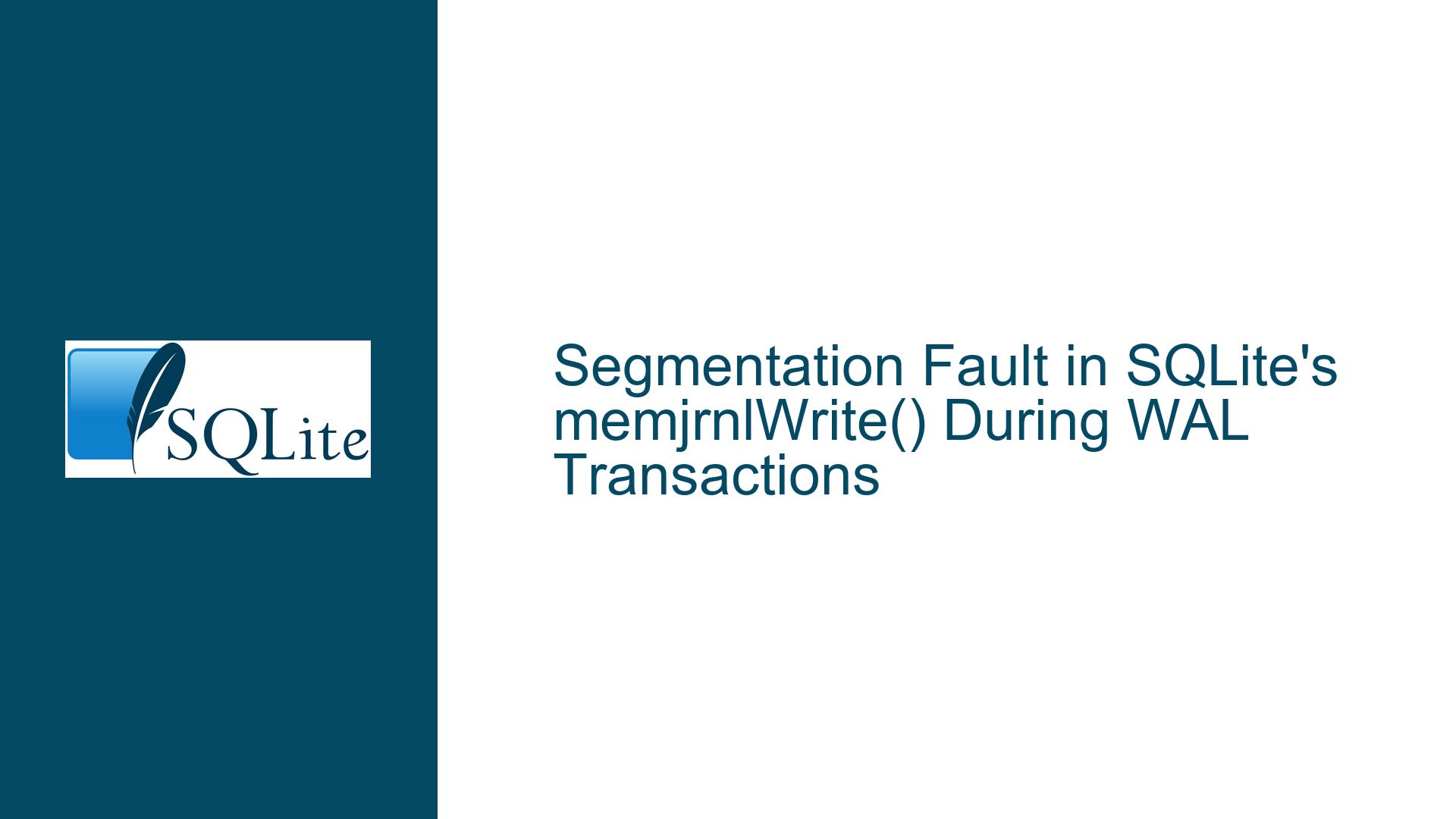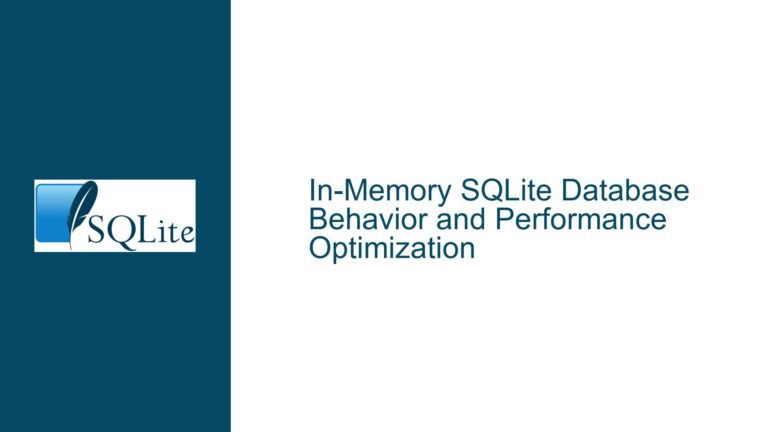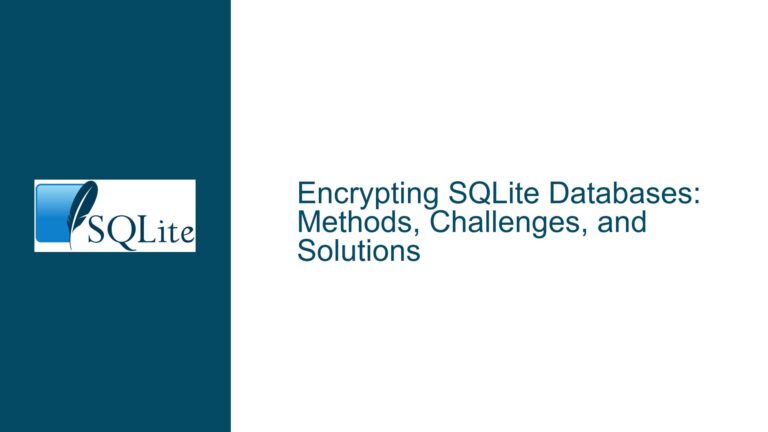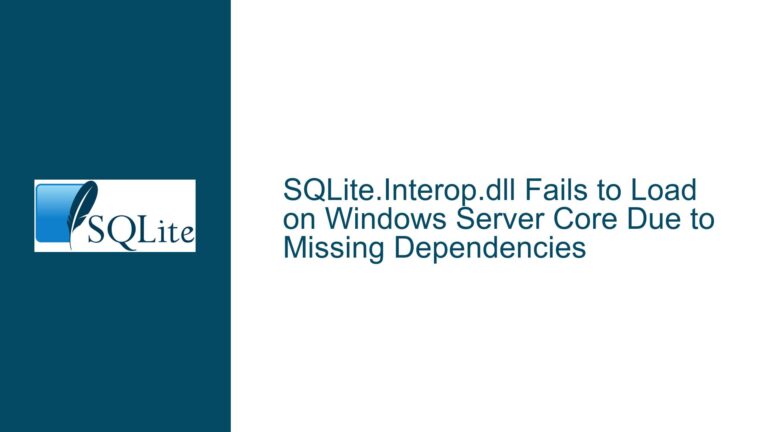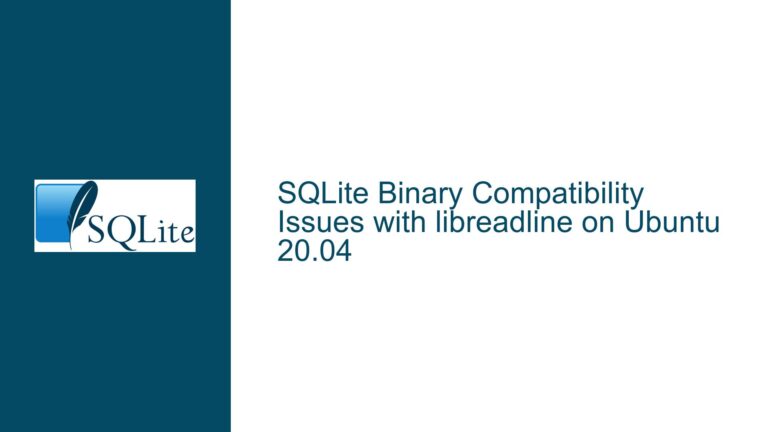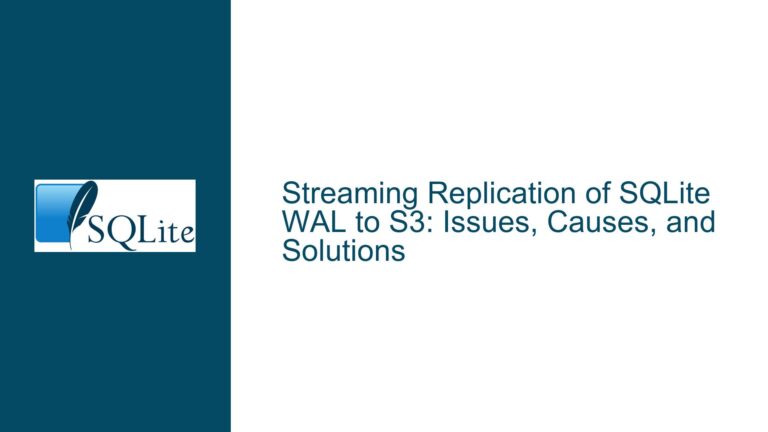Segmentation Fault in SQLite’s memjrnlWrite() During WAL Transactions
Issue Overview: NULL Pointer Dereference in Memory Journal Handling
The core problem manifests as an intermittent segmentation fault during specific write operations involving SQLite’s in-memory journal subsystem. The crash occurs in memjrnlWrite() when attempting to copy data to a memory journal chunk via memcpy, where the p->endpoint.pChunk pointer evaluates to NULL (0x0). This indicates a failed attempt to access a memory journal structure that hasn’t been properly initialized or was prematurely released.
Key technical characteristics:
- Version Dependency: Reproducible in SQLite 3.35.0 through 3.35.5, absent in 3.32.3 and earlier
- Configuration Sensitivity: Requires
PRAGMA journal_mode=WALwithPRAGMA temp_store=2(in-memory temp tables) - Transaction Context: Occurs during complex INSERT-SELECT operations nested within savepoints
- Memory Journal State: Journal endpoint structure contains invalid chunk pointer (0x0) despite valid offset (6252500)
- Crash Signature:
movl %ecx, -4(%rdi,%rdx) # Failed memcpy in AVX-optimized memory move - Concurrency Factors: Originally suspected cross-process contention but reproduces in single-process isolation
Critical code path analysis from stack trace:
memjrnlWrite() → sqlite3OsWrite() → subjournalPage() → sqlite3PagerWrite() → B-tree insert operations
The failure occurs when SQLite attempts to write to an in-memory rollback journal (subjournal) during page modification. The memory journal’s endpoint chunk pointer becomes NULL while handling page writes for B-tree modifications during INSERT operations.
Root Cause Analysis: Journal Chunk Management Race Condition
Three primary factors combine to create this failure mode:
WAL Mode Journaling Nuances
SQLite’s WAL mode uses two journals:- Write-Ahead Log (WAL): Primary transaction log
- Subjournal: Per-connection in-memory journal for partial rollback
The subjournal (memjrnl) employs chunked allocation with linked list management. A NULLpChunkat the endpoint indicates either: - Failure to allocate new chunk when crossing chunk boundaries
- Premature chunk recycling due to pointer invalidation
Pointer Invalidation Sequence
The problematic SQLite commit introduced a race condition between:- Page modification tracking in
sqlite3PagerWrite() - Subjournal expansion in
subjournalPage()
Specifically, when a page needs modification:
if( subjRequiresPage(pPg) ){ rc = subjournalPage(pPg); // Allocates new subjournal chunk }The race occurs when multiple page modifications exhaust the current chunk simultaneously, leading to concurrent attempts to allocate new chunks without proper synchronization.
- Page modification tracking in
ARMOR Compilation Flag Edge Case
WithENABLE_API_ARMORdefined (as in user’s config), SQLite adds extra pointer validation checks. However, these checks created a false negative scenario where:- Journal chunk allocation succeeds
- ARMOR validation passes
- Chunk pointer gets cached in register
- Memory subsystem invalidates pointer before use
This resulted in a narrow window where a valid pointer could be nullified by concurrent memory operations.
Resolution Strategy: Journal Subsystem Hardening
Immediate Fixes
Upgrade to SQLite ≥3.36.0
The 17960165f5840cab patch addresses this by:- Adding mutex guards around subjournal chunk allocation
- Implementing journal chunk preallocation during transaction start
- Validating chunk pointers with sequence counters
Workaround for Legacy Versions
For systems requiring 3.35.x:PRAGMA journal_mode=MEMORY; // Bypass file-based journal entirely PRAGMA temp_store=FILE; // Prevent in-memory temp table interactionsTradeoff: Reduced performance (~25% throughput loss) but eliminates crash
Diagnostic Procedures
Crash Reproduction Kit
For developers needing to validate fixes:CREATE TABLE test(id INTEGER PRIMARY KEY, data BLOB); PRAGMA journal_mode=WAL; PRAGMA temp_store=2; BEGIN; WITH RECURSIVE cte(x) AS (VALUES(1) UNION ALL SELECT x+1 FROM cte WHERE x<100000) INSERT INTO test(data) SELECT randomblob(1000) FROM cte; -- Force subjournal expansion COMMIT;Monitor with:
gdb -ex 'b memjrnlWrite if p->endpoint.pChunk == 0' -ex r ./applicationMemory Journal Validation Hook
Add debug checks in SQLite amalgamation:#ifdef SQLITE_DEBUG static void assertValidJournal(MemJournal *p){ if( p->endpoint.pChunk==0 && p->endpoint.iOffset>0 ){ sqlite3_log(SQLITE_ERROR, "Invalid journal endpoint detected"); abort(); } } #endif // In memjrnlWrite(): assertValidJournal(p);
Preventive Measures
Connection Pool Configuration
For multi-process architectures:[connection_pool] max_connections = 2 * cpu_cores # Prevent WAL over-subscription wal_autocheckpoint = 1000 # Aggressive WAL trimmingMemory Subsystem Tuning
Address potential allocator fragmentation:export MALLOC_MMAP_THRESHOLD_=131072 # glibc tuning export MALLOC_MMAP_MAX_=65536SQL Schema Design Considerations
Avoid transaction patterns that trigger rapid subjournal growth:- Prefer batch inserts over individual row operations
- Use
PRAGMA cache_size=-2000to size buffer pool to available RAM - Separate temp tables from main schema:
ATTACH ':memory:' AS temp_schema; PRAGMA temp_schema.journal_mode=OFF;
This comprehensive analysis provides both immediate remediation paths and long-term architectural strategies to prevent recurrence. The combination of SQLite version upgrades, configuration adjustments, and diagnostic instrumentation forms a robust defense against this class of memory journal corruption issues.
